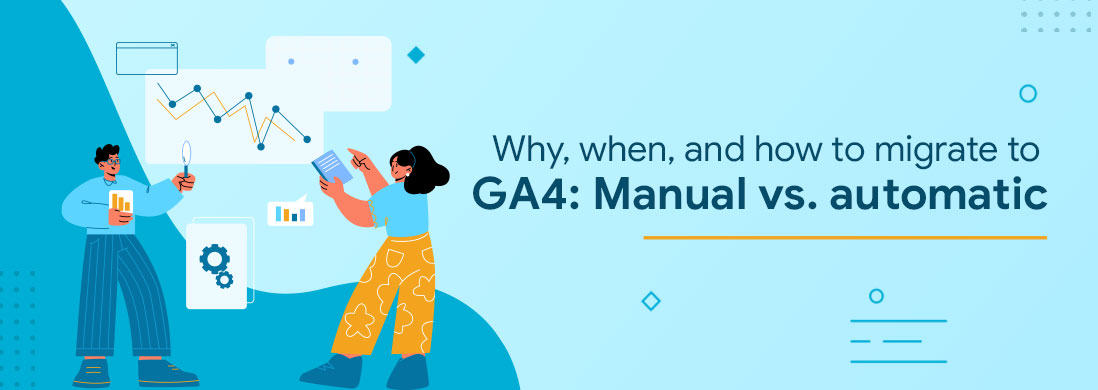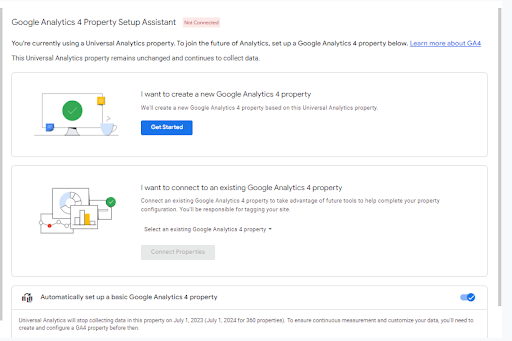Google Analytics 4 (GA4) is the latest version of Google’s popular web analytics platform, offering a range of new and improved features to help you gain insights into your website or app’s performance. One of the newest features of GA4 is the ability for Google to automatically create a GA4 property for you.
In this article, we have looked at and discussed
1. How marketing thrives with GA4?
2. What Are Automatically Created GA4 Properties?
3. Automated GA4 properties: How Do They Work?
4. Why Consider Manual Migration to GA4:
1. How marketing thrives with GA4?
GA4 provides marketers with a more accurate and flexible analytics platform that can help them gain deeper insights into user behavior and create more effective marketing campaigns.
Track User Behaviour more accurately
The main benefit of event-based tracking is that it allows you to track user behavior more accurately. With UA, you can only track user behavior within a single session, but with GA4, you can track user behavior across multiple sessions. This allows you to get a more complete picture of how users are interacting with your website.
Event-based tracking also allows you to get insights into user behavior that would otherwise be impossible to track. For example, you can track how long users spend watching a video, or how many times a user clicks on a button. This type of data can be invaluable for understanding user behavior and optimizing your website.
Offers a Privacy centric approach to analytics
GA4 is all about user privacy and in fact, puts the control of privacy in the user’s hands.
It meets the current and future privacy regulations, such as GDPR and CCPA. It includes features such as data deletion on request, opt-out from tracking, and data retention controls. UA, while it also offers some privacy controls, does not have the same level of privacy features as GA4.
Advanced reporting and analytics
GA4’s predictive insights uses machine learning algorithms to help users identify patterns and trends in their data which might go unnoticed.. For example, it can help users identify which user segments that are most likely to convert, identify drop-offs in the conversion funnel, predict user behaviour which becomes a key indicator in optimizing the website and app
In addition to predictive insights, GA4 also offers more advanced data visualization capabilities, that make it easier to navigate and understand complex data sets.
Users can also create custom reports and dashboards that are tailored to their specific needs, which can help them stay on top of key metrics and performance indicators.
In summary, GA4 offers a more user-centric approach, advanced privacy features, and streamlined reporting capabilities. However, it requires a new implementation and has a steeper learning curve compared to UA. It is important to carefully evaluate the strengths and weaknesses of both platforms when choosing a tracking tool that is best suited for your business needs.
Automatically Created GA4 Properties VS Manually Created GA Properties: What to choose?
2. What Are Automatically Created GA4
An automatically created GA4 property is a GA4 property that Google generates for you based on the data that’s already available in your Google Analytics account. This can include your website or app’s tracking code and the information you provided during the setup process. The goal of automatically created GA4 properties is to make it easier for you to get started with GA4, without requiring you to manually set up a new property.
3. Automated GA4 properties: How Do They Work?
Eligibility :
Unless you choose to not participate, all Universal Analytics properties that have been used within the last year are eligible for automatic configuration with Google Analytics 4. If you wish to opt out of this, you must do so by February 28th. It may take additional time for more complex features, like goals, audiences, and Google Ads links, to be migrated.
Note: If you have a Universal Analytics 360 property, Google Analytics 4 will not be configured automatically, and you will need to migrate on your own before your property stops processing data on July 1, 2024. Contact your Google representative if you have any questions.
The pros of automatically generating GA4 properties include:
Convenience: It’s quick, it’s easy, and it’s a one-stop shop for GA4 setup. Just click a few buttons and you’re done.
Access to GA4 features: Automatically created GA4 properties will give you access to all the latest and greatest GA4 features, including built-in tracking for web and app, advanced machine learning algorithms, and more.
BUT…
The Cons of automatically creating GA4 properties includes:
Lack of control: Automatically created GA4 properties do not allow for customization or control over the tracking code, data collection, and reporting. This means you may not be able to track the specific metrics or data that you need for your website or app.
Limited data accuracy: Automatically created GA4 properties can lead to incomplete or inaccurate data collection. This is because they rely on automatic data collection and do not allow for manual tracking, which can lead to missing data or incorrect tracking.
Inadequate reporting: Automatically created GA4 properties may not provide the level of detail or granularity in reporting that you need for your website or app. This could lead to difficulties in analyzing the performance of your site and making informed decisions about how to optimize it.
Tatvic has offered similar expertise to our client to make the flow more accurate and personalized
So, what’s the alternative? Manual migration.
Why Consider Manual Migration to GA4:
Greater control: When you manually migrate to GA4, you have the power to set up your property exactly as you want. This includes customizing event tracking and custom dimensions, which can lead to more accurate insights and analysis.
Increased accuracy: With manual migration, you’ll have the ability to ensure that your data is properly transferred and accurately reflects your website or app performance. This means no more worrying about incorrect insights and wasted time chasing down false leads.
More transparency: With manual migration, you have visibility into each step of the migration process, making it easier to identify and resolve any issues that may arise.
Better integration with other tools: With manual migration, you can ensure that GA4 integrates seamlessly with other tools and platforms you are using, such as Google Tag Manager or your website platform.
Ability to address specific needs: Manual migration allows you to address specific requirements and requirements that may not be met through automatic migration, such as custom tagging or data processing.
So, what’s the verdict? The choice between automatically created GA4 properties and manual migration will depend on your specific needs and goals. If you’re looking for a quick and easy solution with access to GA4 features, automatic creation might be right for you. But if you want greater control and increased accuracy, manual migration is the way to go.
As Premier Google Partners with 90+ successful migrations, we have the expertise to make your transition seamless. Browse our case studies to learn more.
In the end, it all comes down to what you value most in your web analytics tool. Do you want convenience and access to features, or do you want the ability to fully customize your setup and ensure the accuracy of your data? The choice is yours – and whichever path you choose, GA4 is sure to be a game-changer for your website and app performance analysis.
4. Key Takeaways
Google Analytics 4 (GA4) helps marketers gain deeper insights into user behavior and create more effective marketing campaigns.
Automatically created GA4 properties are generated by Google based on the data in your Google Analytics account, and while they offer convenience and access to GA4 features, they also lack control, limited data accuracy, and inadequate reporting.
Manual migration offers greater control, increased accuracy, and the ability to customize event tracking and dimensions for more accurate insights and analysis.
Careful evaluation of the strengths and weaknesses of both platforms is necessary to choose the right tracking tool that suits your business needs.




